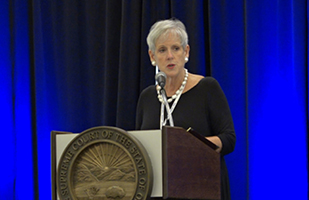Evictions, Bail, COVID Emphasized in State of the Judiciary

Chief Justice Maureen O'Connor encouraged Ohio's judges to remain proactive in handling COVID-related issues during her State of the Judiciary address.

Chief Justice Maureen O'Connor encouraged Ohio's judges to remain proactive in handling COVID-related issues during her State of the Judiciary address.
With the delta variant causing spikes in illnesses across the state, Ohio Supreme Court Chief Justice Maureen O’Connor continued to stress COVID public health recommendations for court operations during her annual State of the Judiciary address.
“I beg you to keep yourself safe and all of your employees safe. You all know the drill,” Chief Justice O’Connor said, with measures including masks for everyone inside their buildings, vaccinated or not.
The chief justice applauded judges and their staffs statewide for innovating to keep courts open during the last 18 months, despite the length and seriousness of the crisis.
Thursday’s address was the chief justice’s 11th at the annual meeting of the Ohio Judicial Conference in Columbus.
She noted that continued assertiveness during the pandemic extends to the recent change regarding evictions. With the statewide moratorium over, the Supreme Court produced a toolkit to help with the expected increase in housing issues as early as possible.
“Now, more than ever, courts need to be proactive to divert tenants and landlords away from formal court action and instead seek rental assistance or alternative forms of dispute resolution,” Chief Justice O’Connor said.
Adjustments over the past 18 months led to technological innovations in the courts to promote safety and enhance efficiency -- and to keep the judicial branch operating. A Supreme Court task force took those developments to another level by making 97 recommendations for affordable and manageable upgrades for the future.
“This makes the iCOURT report not only a must-read, but a must-do when it comes to considering recommendations that fit your court and your circumstances,” Chief Justice O’Connor said.
On top of problems in the present, the Supreme Court has made strides in the last few years toward addressing prolonged procedural issues, notably bail reform.
“Thanks to recent changes, courts in Ohio must use the least-restrictive bond conditions and least amount of monetary bail to secure a defendant’s appearance,” she noted.
Bail reform in many ways connects with an overarching justice system concern – racial fairness. After years of development, and in response to calls for data and transparency to confront racial justice concerns, the implementation of a statewide sentencing database is underway, with four courts piloting the program and a dozen more in the planning process.
“This will give us the whole picture of our criminal justice system in Ohio. It will provide a foundation for fairness,” Chief Justice O’Connor said.
As leaders in the community, judges can positively impact Ohioans through awareness, the chief justice said, whether it’s championing systemic reform or assisting with civic education in their communities.
“Each of you holds a special place to make a difference in our state of Ohio, and our nation, and I thank you for that,” she said.

